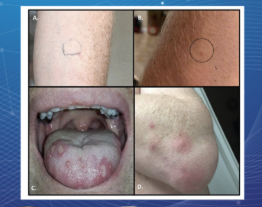Few illnesses in the rapidly changing field of medicine are as elusive and incredibly complex as Behçet’s disease. This uncommon multisystem disorder, which is frequently shortened to BD, affects blood vessels all over the body and results in a series of symptoms that are remarkably varied but deceptively disjointed. Due in large part to the nonlinear nature of BD, many patients do not receive a diagnosis for years. It imitates. It changes. And even seasoned experts are frequently confused by it.
Behçet’s disease, which was initially discovered along the ancient Silk Road, is much more common in places like Turkey, the Middle East, and some parts of Asia. However, it’s not limited by geography. As awareness and diagnostic sophistication increase, more cases are being found globally. The fact that BD functions like a stealth virus but is actually an autoimmune disease makes it especially difficult to treat. Additionally, scientists have recently started to gain a better understanding of how environmental triggers, genetics, and immune dysfunction interact to cause this inflammatory storm.
BD Disease (Behçet’s Disease) – Key Information
| Category | Details |
|---|---|
| Full Name | Behçet’s Disease (also known as Behçet’s Syndrome) |
| Abbreviation | BD |
| Disease Type | Rare autoimmune vasculitis affecting blood vessels |
| First Described By | Dr. Hulusi Behçet (1937) |
| Common Symptoms | Mouth ulcers, genital sores, eye inflammation, skin lesions, joint pain, digestive issues |
| Body Systems Affected | Mucosal tissue, skin, joints, eyes, gastrointestinal tract, nervous system, blood vessels |
| Triggers & Risk Factors | Genetic markers (e.g., HLA-B51), environmental triggers (infections), male sex, age 20–40 |
| Diagnostic Challenge | No definitive test; diagnosis based on recurrent symptoms and clinical criteria |
| Treatments Available | Corticosteroids, colchicine, immunosuppressants, biologics, topical agents |
| Reference Website | Cleveland Clinic – Behçet’s Disease |
A Chameleon in the World of Chronic Diseases
There isn’t just one defining symptom that Behçet’s disease uses to announce itself. Rather, it quietly infiltrates, frequently starting with intermittent, excruciating mouth ulcers. Next are inexplicable genital sores, which are occasionally written off as infections. Patients may experience joint swelling, eye pain, or skin nodules over time. The illness can even impact the digestive system, blood vessels, or brain, which makes it extremely challenging to monitor and even more so to treat.
BD is especially adaptable when it comes to autoimmune disease. It does not target a particular tissue or organ, in contrast to lupus or rheumatoid arthritis. Rather, it causes inflammation throughout the vascular system, which leads to a recurrent pattern of symptoms. Patients frequently switch between dermatologists, rheumatologists, ophthalmologists, and gastroenterologists due to this unpredictability until someone makes the connection.
The Silent Suspects and the Genetic Mysteries
According to researchers, Behçet’s disease is caused by an immune system that has been genetically primed to react excessively to environmental triggers, which could be viruses or bacteria. Many BD patients, especially those from areas along the ancient Silk Road, have the genetic markers HLA-B5 and HLA-B51. The relationship is particularly complicated because not everyone who possesses these markers goes on to develop the disease.
Using information from immunological profiling and genome studies, researchers have started to pinpoint the mechanisms underlying BD’s inflammatory loops. However, unlike monogenic disorders, there is no discernible pattern of inheritance, and the precise mechanisms are still being investigated. To put it another way, BD frequently strikes suddenly, even in those who have no family history.
Clinical Criteria: Making a Disease Diagnosis Without Testing
Pattern recognition is essential for BD diagnosis. A patient usually needs to have recurrent mouth ulcers in addition to two or more of the following symptoms: genital sores, eye inflammation, skin lesions, or a positive pathergy test (where the immune system overreacts to a minor skin prick) at least three times a year. Doctors frequently rule out a number of other illnesses first because these symptoms can mimic those of other conditions like Crohn’s disease or systemic lupus erythematosus.
Patients may find that process to be excruciatingly slow. Underdiagnosis or misdiagnosis are frequent, particularly in nations where BD is uncommon or unknown. However, after a diagnosis, a customized treatment plan that takes into account risk factors, organ involvement, and symptom severity can be started.
Coping With BD: Therapy, Handling, and Prospects
Although BD has no known cure, with the right treatment, its symptoms can be remarkably well-managed. During flare-ups, corticosteroids, such as prednisone, are frequently prescribed to reduce inflammation. Medications like methotrexate and colchicine are frequently used to suppress immune overactivity as part of ongoing management.
Biologics, such as etanercept or infliximab, which block particular inflammatory proteins like TNF-alpha, can be especially helpful in more severe cases. In patients with significant blood vessel involvement or eye inflammation, these treatments have dramatically decreased disease activity.
For more localized symptoms, topical treatments such as steroid mouthwashes, eye drops, and skin ointments are used to provide patients with additional relief without causing systemic side effects. Drugs like apremilast, which is approved specifically for mouth ulcers caused by BD, have given people who were previously dependent on high-dose steroids new hope during the past ten years.
The Experience of the Patient: From Isolation to Advocacy
It can be emotionally and physically taxing to live with BD. Patients may feel alone due to the unpredictable nature of flare-ups and the stigma associated with visible sores or redness. However, new communities are emerging as awareness grows. Patient-led awareness campaigns, nonprofit foundations, and online support groups have all been particularly creative in educating the public and cutting down on diagnostic delays.
Digital symptom trackers and telehealth consultations proved to be very effective for tracking BD flares during the pandemic, when access to specialists became increasingly limited. As these digital tools develop further, they might provide fresh approaches to episode prediction and treatment plan customization using real-time data.


